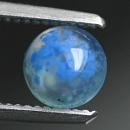|
|
||||||||||||||||
|
||||||||||||||||
|
||||||
|
|
|
|
Connellite
(inclusions
in Quartz) |
|
| | |
| Discovered in 1850; IMA status: Valid (pre-IMA; Grandfathered) | ||
|
| ||
|
Chemistry |
|
|
| |
|
Cu36(SO4)2Cl6(OH)62 • 6-12(H2O) | |
|
|
Hydrated Copper Sulfate Chloride Hydroxide |
|
Molecular Weight: |
2,043.53 gm |
|
Composition: |
Copper |
59.08 % |
Cu |
73.96 % |
CuO |
|
|
Hydrogen |
1.87 % |
H |
16.75 % |
H2O |
|
|
Sulfur |
1.57 % |
S |
3.92 % |
SO3 |
|
|
Chlorine |
6.94 % |
Cl |
6.94 % |
Cl |
|
|
— |
— % |
Cl | -1.57 % |
-O=Cl2 |
|
|
Oxygen |
30.53 % |
O |
|
|
|
|
|
100.00 % |
|
100.00 % |
= TOTAL OXIDE |
|
|
|
||||
|
Classification |
|
|
| |
|
Halides | |
|
3/D.03-40 | |
|
|
3 : HALIDES
|
|
Related to: |
Isostructural with Buttgenbachite. Connellite-Buttgenbachite Series. |
|
Varieties: |
None |
|
Synonyms: |
Carbonatian Connellite, Ceruleofibrite, Footeite, Sulphato-chloride of Copper, Tallingite |
|
|
|
|
Crystal Data |
|
|
|
|
|
As acicular prismatic crystals, elongated and striated || [0001], to 2.5 cm; commonly in tight radiating groups; fibrous, felted, or crusty aggregates. |
|
|
None |
|
|
|
|
|
Physical Properties |
|
|
|
|
|
None observed |
|
|
Splintery |
|
|
Brittle |
|
|
3.0 |
|
|
3.36 - 3.41 (g/cm3) |
|
|
None |
|
|
Not Radioactive |
|
|
Other: |
Soluble in acids and in ammonium hydroxide. Insoluble in water. |
|
|
|
|
Optical Properties |
|
|
|
|
|
Blue, blue-green; blue in transmitted light |
|
|
Transparent |
|
|
Vitreous |
|
|
1.724 - 1.758 Uniaxial ( + ) |
|
|
0.014 - 0.026 |
|
|
n/a |
|
|
None |
|
|
|
|
|
Occurances |
|
|
|
|
|
Geological Setting: |
An uncommon secondary mineral in the oxidized portions of copper deposits. |
|
Common Associations: |
Atacamite, Azurite, Botallackite, Cuprite, Langite, Malachite, Spangolite |
|
Common Impurities: |
n/a |
|
Type Locality: |
Wheal Providence, Providence Mines, Carbis Bay, St Ives, St Ives District, Cornwall, England, UK |
|
Year Discovered: |
1850 |
|
View mineral photos: | |
|
|
|
|
More Information |
|
|
|
|
|
| |
|
|
|
|
Distribution:
In England, in the Wheals Gorland, Unity, Edward, the
Botallack mine, and others in St. Just, and several
other mines in Cornwall. At Southwick Cliffs, near Dalbeattie,
Kirkcudbrightshire, Scotland. In the Britannia mine,
Snowdonia, Wales. At the Cap Garonne mine, near le Pradet,
Var, France. In the Sa Duchessa mine, Oridda district,
Sardinia, Italy. From Laurium, Greece, in slag. At Fontana
Rossa, Corsica, France. From Weibing, Salzburg, Austria.
In the Clara mine, Black Forest, Germany. In the USA,
in Arizona, from several mines at Bisbee and in the
Toughnut mine, Tombstone, Cochise County; in Utah, from
the Grand Central mine, Tintic district, Juab County
and the Gold Hill mine, Tooele County. At Spring Creek
and the Ediacara mine, Flinders Ranges, South Australia,
and at Broken Hill, New South Wales, Australia. In the
Marharahara mine, near Woodville, New Zealand. Increasingly
recognized from other minor localities. |
|
|
We
have not photographed our Connellite
gems yet. Please
check back soon. |
